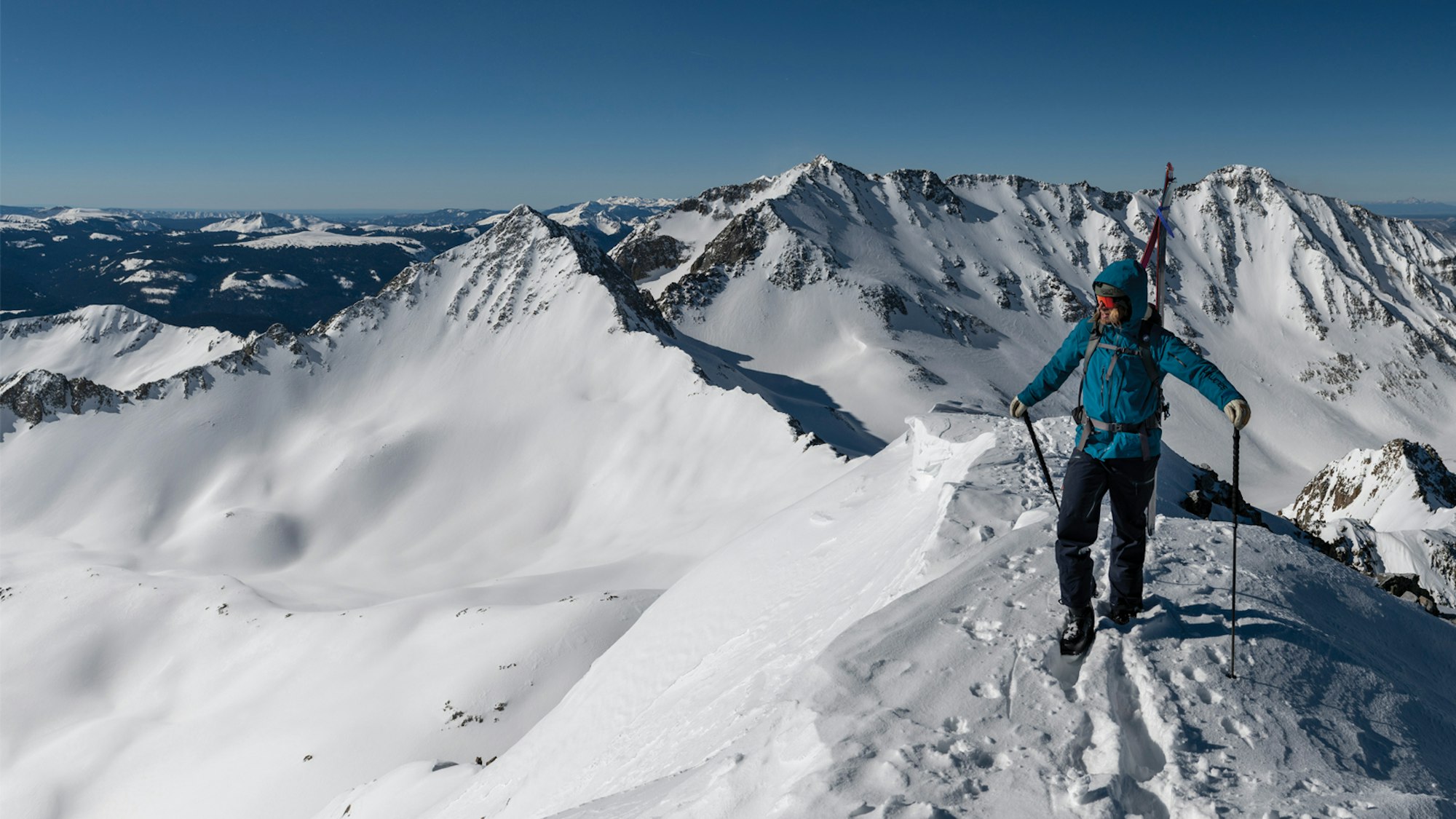Cody Townsend’s ambitious project, The Fifty, is a deep journey into the skier’s soul
WORDS • DONNY O’NEILL | FEATURED IMAGE • Weston Shirley
I pick up Cody Townsend from the Hestra USA headquarters in Arvada, Colorado, on a warm October day. He’s in town for the premiere of Peak Obsession, a short film showcasing his climb and ski of the mighty Meteorite Peak in Alaska with legendary snowboarder Jeremy Jones. The movie is a spin-off of The Fifty, Townsend’s video series documenting his ambitious venture to climb and ski all of the inclusions in the 2010 book, Fifty Classic Ski Descents of North America—a coffee table fixture for many backcountry skiers—in three years. Today, I’m joining him on a training hike as part of his preparation for a second winter of ticking off lines. With two full water jugs weighing down our packs to the tune of about 55 pounds, we’ll make the 4.85-mile, 1,110 vertical foot hike of Mount Galbraith in the foothills of nearby Golden. Townsend, while still the gregarious, amiable and fun-loving guy I’ve come to know during previous meetings, seems hyper-focused.
It comes with juggling an inconceivable to-do list associated with The Fifty. When he returned home to Lake Tahoe last May after climbing and skiing 17 objectives, he hit a wall. The 36-year-old couldn’t get out of bed for three days. Four continuous months of traveling the continent, recruiting worthy ski partners and gathering knowledge to safely climb and ski nearly one-third of the book, all while developing, filming and producing webisodes for biweekly distribution, had overwhelmed his mind and, subsequently, his body. “When you’re peaking that intensely—when you’re all adrenaline and endorphins and going beyond hard—it breaks you down mentally as much as it does physically, and then your mind breaks down your body,” says Townsend.
Despite the exhaustion, Townsend attempted three more lines at the end of May, ticking off Mount Shasta and the Watson Traverse on Mount Baker, but turning around on Mount Rainier. Then, he took two months to reset mentally. He’s spent the majority of the summer in the office, planning budgets, pitching proposals, compiling analytics for the initial run of episodes, editing video and generally organizing the production of another season of the web series singlehandedly. After the premiere of Peak Obsession, Townsend is off to France for a screening at the High Fives Film Festival, and the film will appear at a handful of other events during the fall. In the spare hours he has, he’s lugging 50-plus-pound water jugs up hiking trails to train before the snow flies. I surmise there’s simply no time to be distracted in a world consumed by The Fifty. Now that winter is on the doorstep, his focus narrows even further.
From the time we get in the car, through the up and down of our hike, conversation flows like a river fat with mountain snowmelt. Naturally, we talk about The Fifty, but the meandering trail through ponderosa, piñon and spruce opens up conversation to Townsend’s countless other interests. Topics range from the San Francisco 49ers to the disagreement between Canadians and Americans over how to properly set a skin track to the omnipresence of people curating their own brands, and it seems as though we could talk forever if we wanted to. It’s evident that Townsend has done in-depth studies on a wide range of interests that occupy his mind as he traverses up and down the biggest mountains in North America. The basis for the training hike we complete, for example, comes from notes Townsend took while reading Training for the New Alpinism: A Manual for the Climber as Athlete, by famed climbers Steve House and Scott Johnston. His mind is the biggest tool he’s relied upon in preparation for this untested goal, his experience in ski mountaineering paling in comparison to a decade-plus pillaging big-mountain descents with the aid of helicopters and snowmobiles. Heading into this season, his hunger for, and accumulation of, this information adds a few chinks to his mental armor as he attacks The Fifty. It’s what makes him the perfect, albeit unlikely, candidate to complete the mission.
According to his mother, Peggy, when Townsend finds a topic of interest, he devours it with an insatiable, lion-like appetite, and it’s been like this since he was a child. “One thing was cooking. I worked… when I came home, we would cook together,” she recalls. “He was just three or four, and he would be up on the counter watching and helping me cook. He started watching The Frugal Gourmet on TV and then watching Alton Brown and learning about the actual science of cooking.”
His wife, professional skier Elyse Saugstad, concurs that Townsend goes all in on these subjects. When the couple purchased their house in Lake Tahoe, it needed a lot of remodeling. Hiring outside help wasn’t an option for Townsend, who took on the brunt of the work fixing up the house. “He doesn’t have any experience with carpentry, per se, but he’s the kind of guy that wants to do it himself,” says Saugstad. “And if that means spending hours on YouTube trying to figure it out, he’ll do it. When I look around the house at all of the remodeling we did, the majority of it was done by Cody. When he dives into something, he does it full-bore and wants to do it well.”
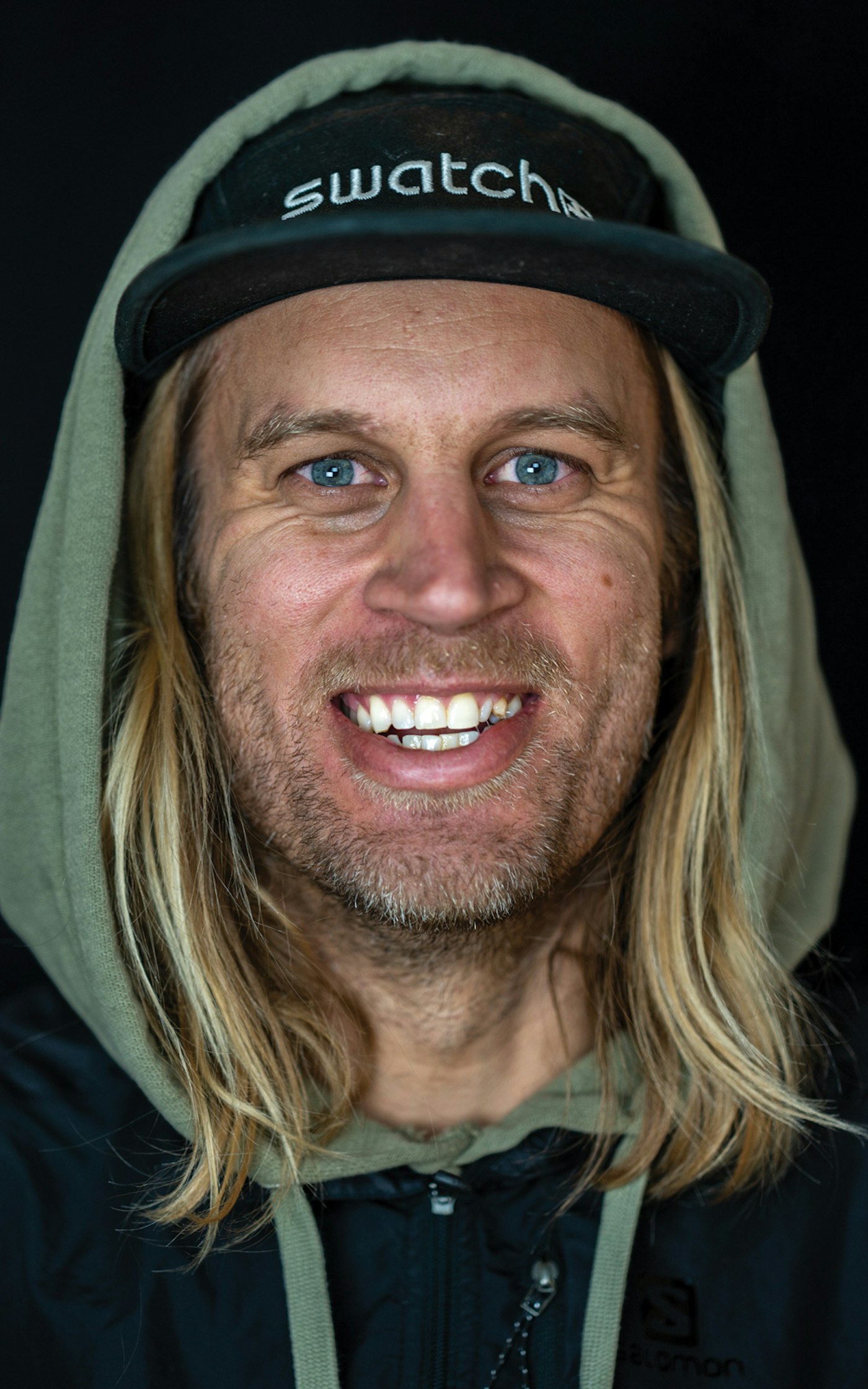
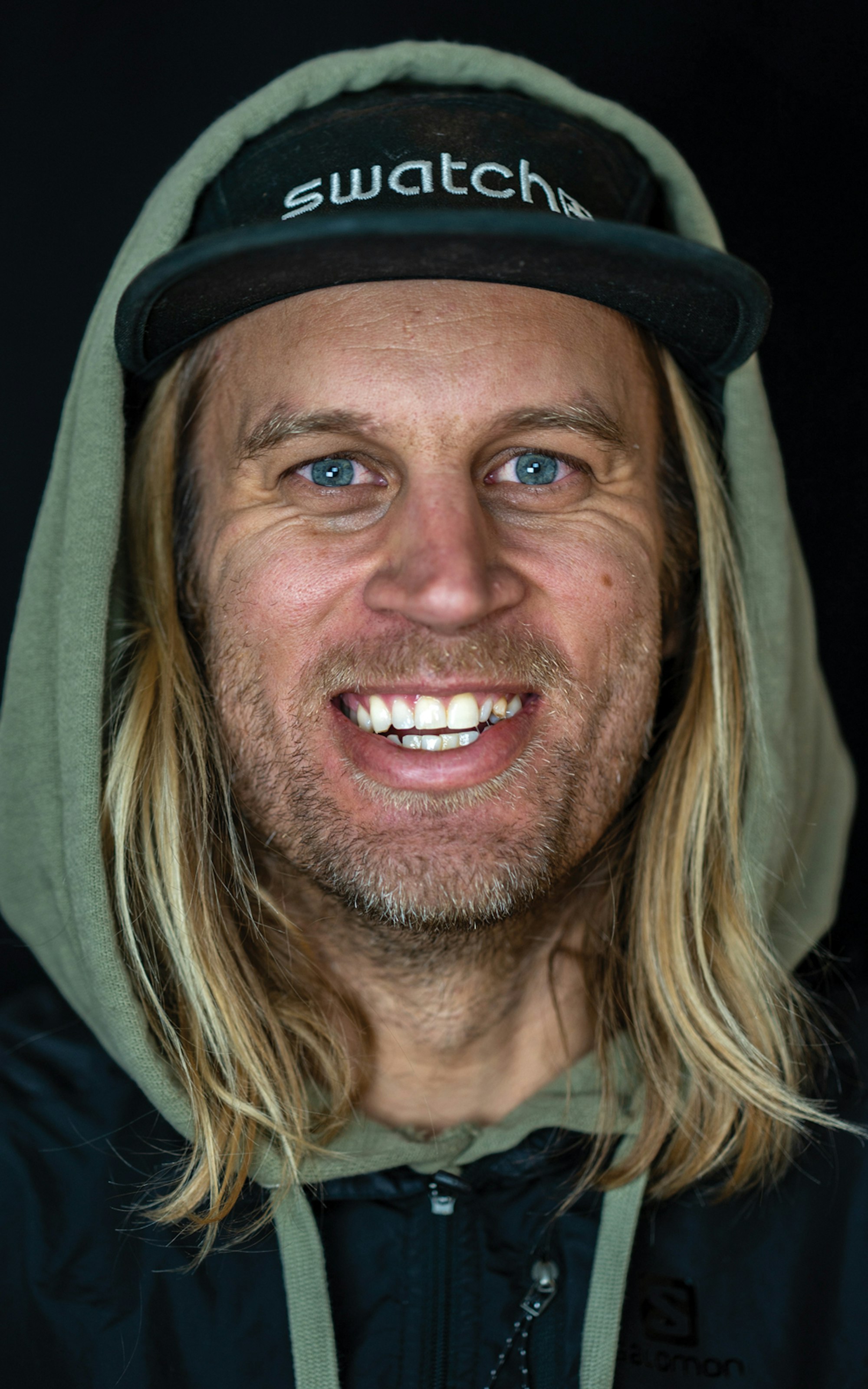
It’s no different when it comes to The Fifty. Townsend’s willingness to jump into a project that requires skills and experience he doesn’t necessarily have parallels his decision to plunge headfirst into the dangerous waters of one of ski mountaineering’s milestone goals.
“I am not the most likely person to do this. There are fitter ski mountaineers; there are bolder ski mountaineers and there are far more experienced ski mountaineers that have all the technical skills [and] could do this better than me,” Townsend says. “But I looked at it as, ‘Could you, who you are as a person, where you’re at in your life, do this?’”
Townsend’s humanizing weaknesses are what make this project so relatable from the viewers’ perspective; he’s not a superhero, despite being the star of countless big-mountain film segments and a 2015 viral video clip of him skiing “The Crack” in Alaska that elevated his status above the insular ski world. He’s attempting a feat no other has accomplished, but there’s no macho ego attached to him. On our hike, he makes fun of himself, saying, “if you would have told me 10 years ago that in 2019 I would only ski tour, ski on skinny skis and not jump off cliffs, I would’ve said, ‘That guy sucks and I want to kick his ass.’ I’d actively talk shit about myself.” Townsend’s a relatable guy that you could imagine joking and sharing stories with around a campfire. That’s the underlying message that Townsend conveys with The Fifty, and what has made it so successful in its initial release.
As of October 19, 2019, the 18 episodes included on Townsend’s YouTube channel have garnered over 789,000 views. The series’ personal vlog format is what makes Bjarne Salén, the principal cinematographer for The Fifty, so instrumental in that success. Salén is best known as the close friend and filmer for the late Andreas Fransson, where he proved his ability to haul video equipment onto steep, exposed lines to capture death-defying descents. Episodes of The Fifty combine GoPro footage—shot by Townsend, Salén and accompanying partners—and clips shot on hand-held camera equipment by Salén, who is with Townsend step-by-step on each line attempt. Salén’s “on-the-ground” perspectives give viewers a sense of place—bushwhacking on the flanks of Mount Currie in British Columbia, clinging to Pontoon Peak in Alaska or teetering over exposure on Colorado’s Pyramid Peak—that draws them in.
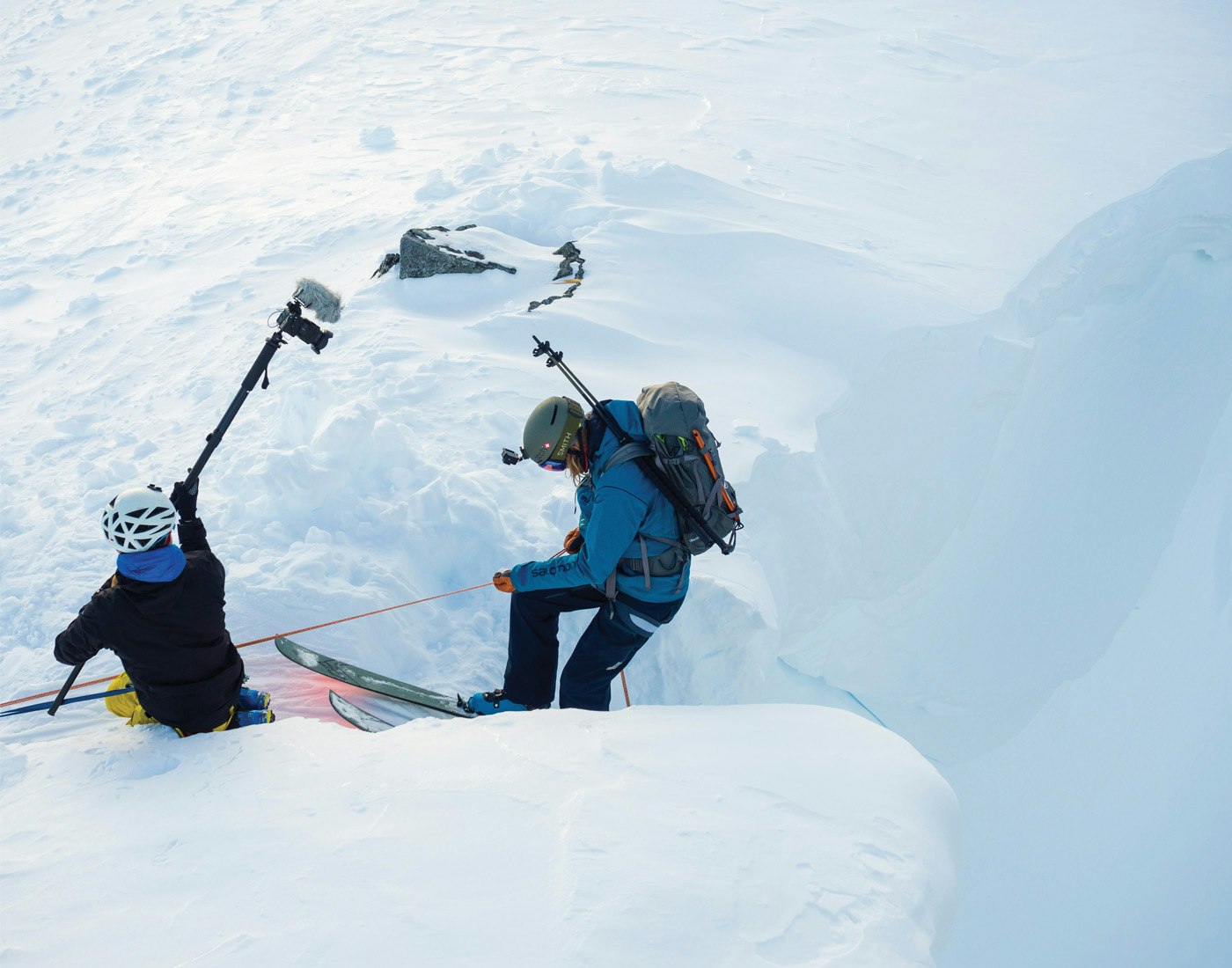
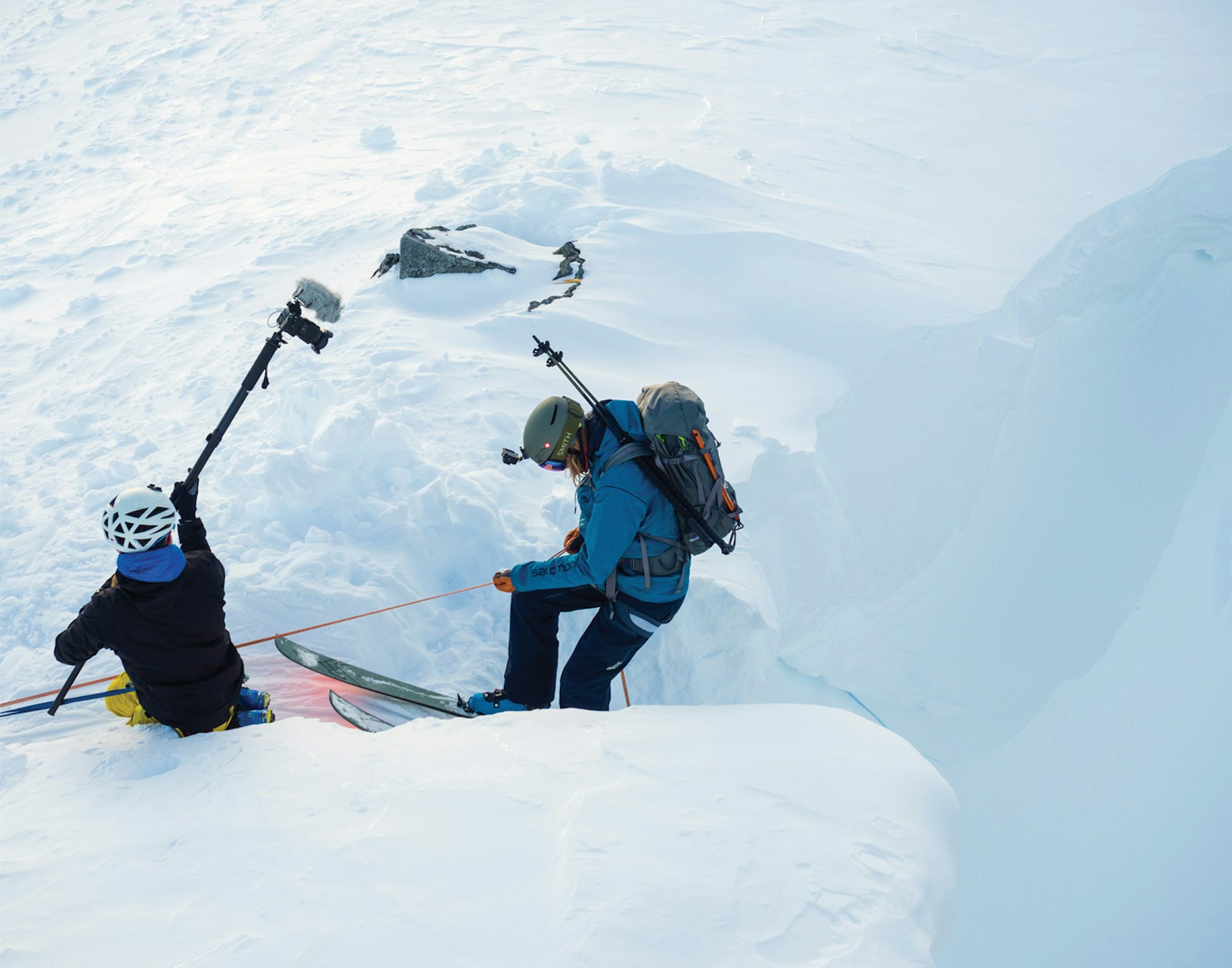
Just one example of what filmer Bjarne Salén brings to the table for The Fifty. | PHOTO: Chris Christie | LOCATION: Mount Currie, BC
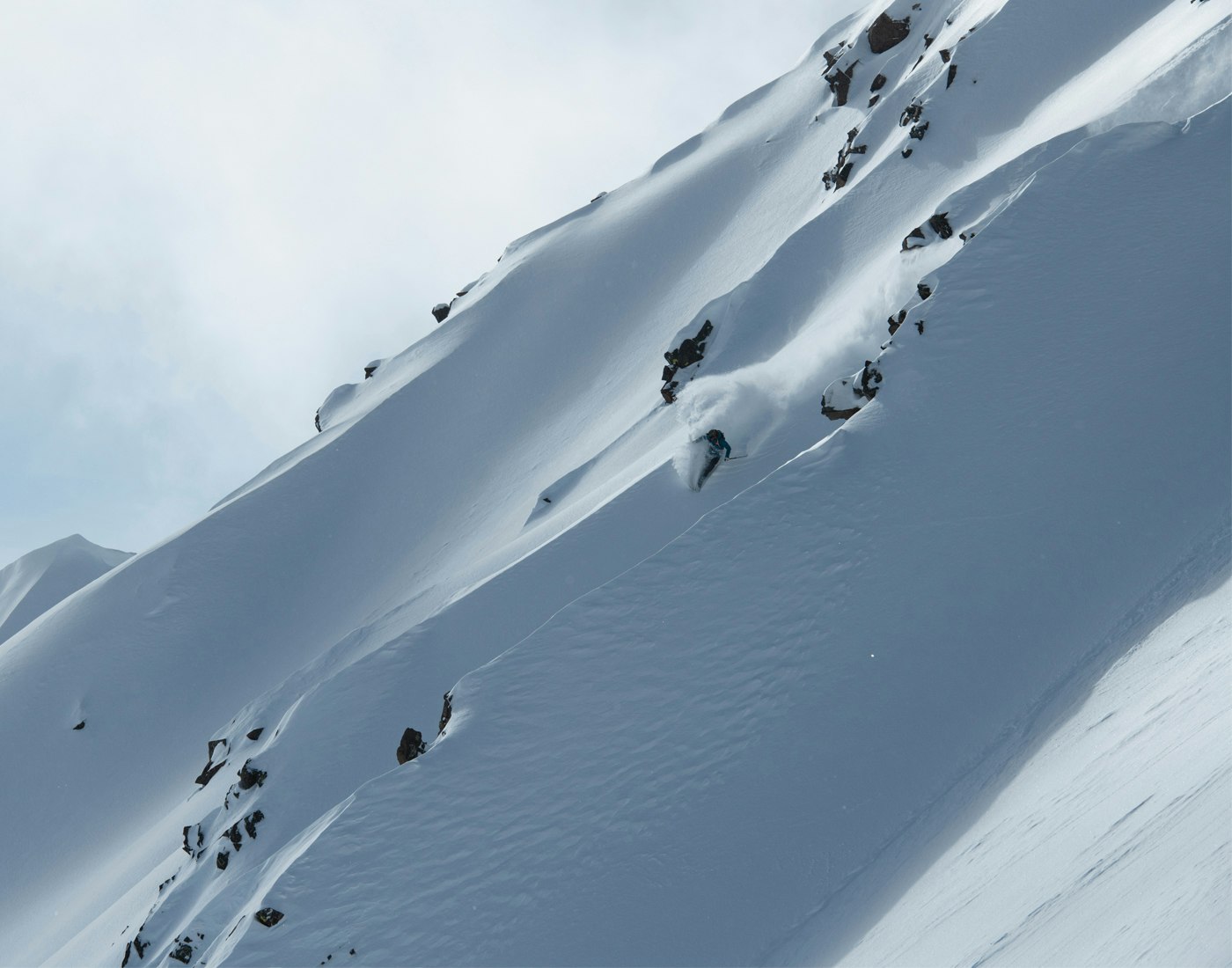
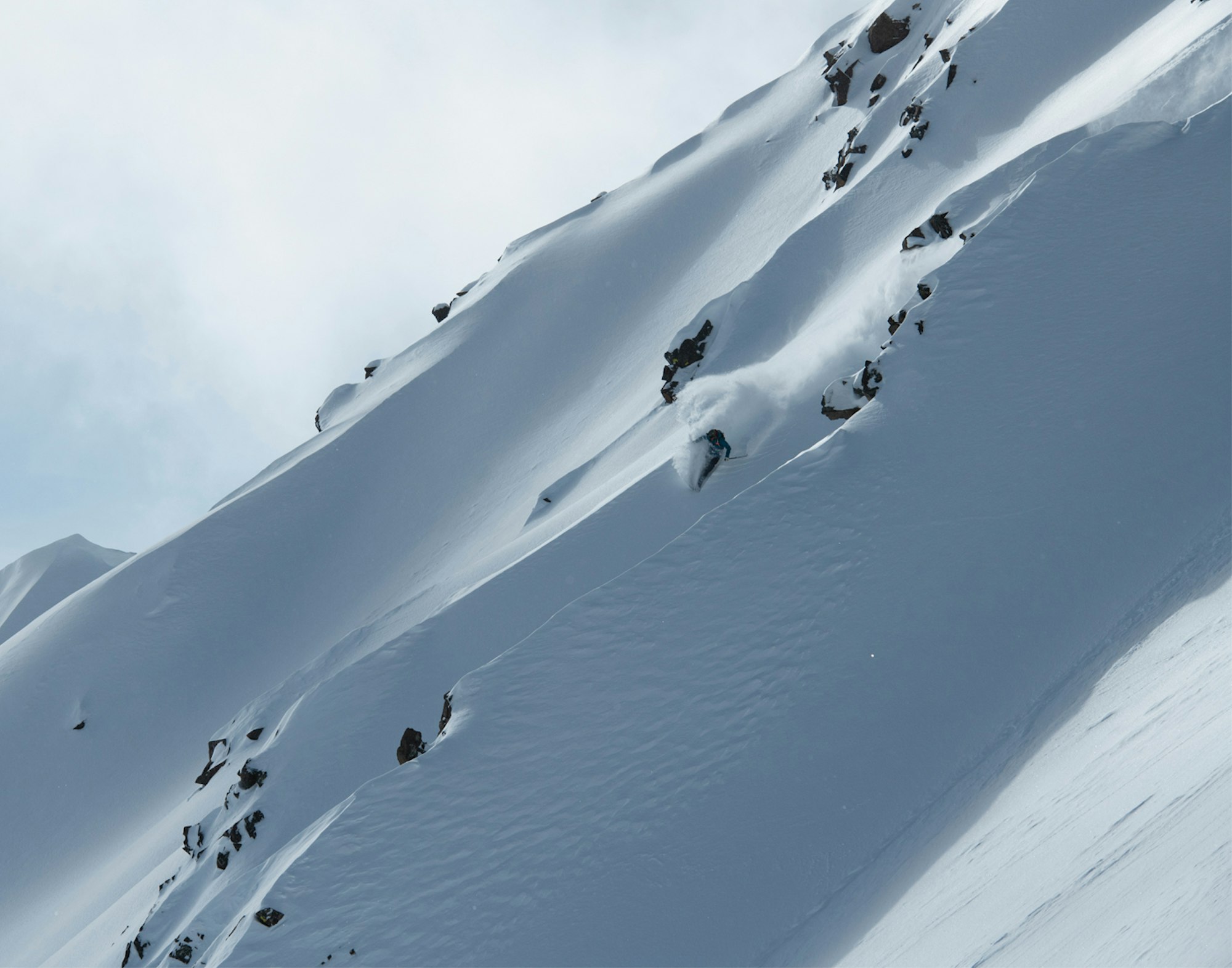
PHOTO: Weston Shirley | LOCATION: Mount Superior, UT
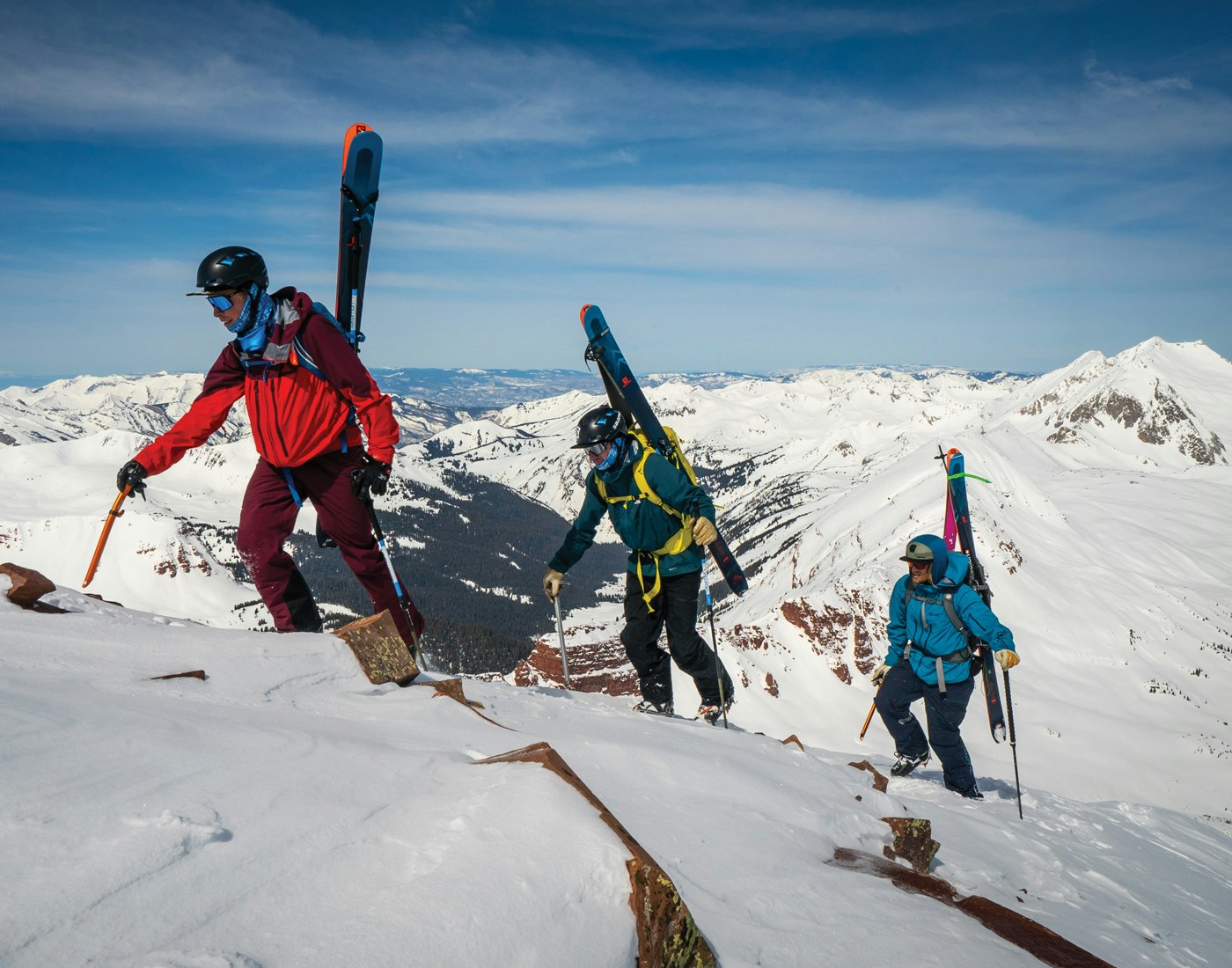
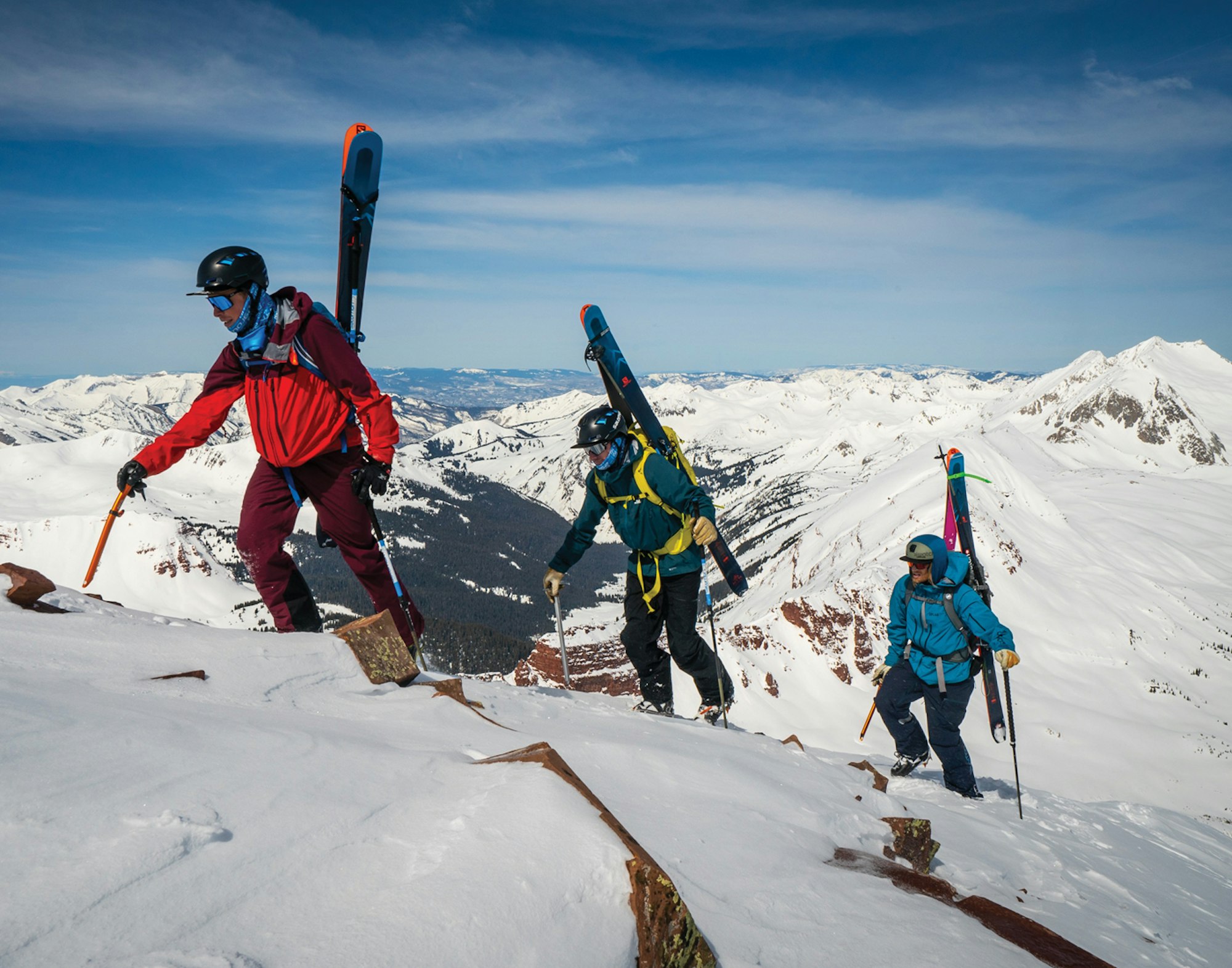
Townsend following fellow Salomon teammates and Aspen locals Pete Gaston and Anton Sponar to the top of North Maroon Peak. | PHOTO: Bjarne Salén| LOCATION: North Maroon Peak, CO
“There’s so much more to show on projects like these than just skiing and that is what people appreciate watching,” says Salén. “Cody is also a great character in front of the camera, which makes it all so much better.”
It also allows Townsend to take a subject matter like ski mountaineering and make it lighthearted, in turn, shedding his superhero cape for an everyman’s kit. He mentions to me a chapter from Deep Survival: Who Lives, Who Dies and Why, in which author Laurence Gonzales highlights a group of fighter pilots who fully acknowledge and accept the risk of their job, and therefore can swap fear for humor. Townsend plays on that notion in the episodes, like when a gust of wind blankets him in snow while climbing up the Ford-Stettner Couloir on the Grand Teton and he says, nonchalantly, “Haven’t taken a shower in a couple of days, glad I just got one.” By interspersing the benign conversations and funny moments that happen during “Type 2 Fun” with the serious ones, he’s highlighting the bordering-on-absurd banter that every backcountry skier can relate to.
Aside from his skiing prowess, fans of Townsend have always flocked to him because he’s hilarious and willing to poke fun at himself and his friends. Staying true to this, he’s found ways to make entire episodes comedic. Parodying the obsession of first descents, he, along with Saugstad and pro skier Connery Lundin tick off the first mono-ski, ski blade and butt-naked descents of Nevada’s Terminal Cancer couloir. Poking fun at the ski-mo race world, he dons a speed suit and looks to break the FKT (Fastest Known Time) on Whistler’s Spearhead Traverse.
The point-of-view shots of Townsend suffering, admitting fear or analyzing conditions gives viewers a glimpse into his evolving self-awareness; as he overcomes challenges in these imposing, dangerous mountainscapes, he’s learning about himself. The backcountry is generally devoid of the hustle and bustle of the resort; it’s a place where skiers can contemplate in the serenity of the wilderness. Viewers can connect with this on a human level.
“It’s competing against yourself but learning about yourself. I’ve learned more about myself because of the mountains than any other avenue. The mountains can be a mirror for who you are as a person,” he says. “It’s this reward of getting through something that’s challenging and scary. It’s a unique quality shared among all people.”
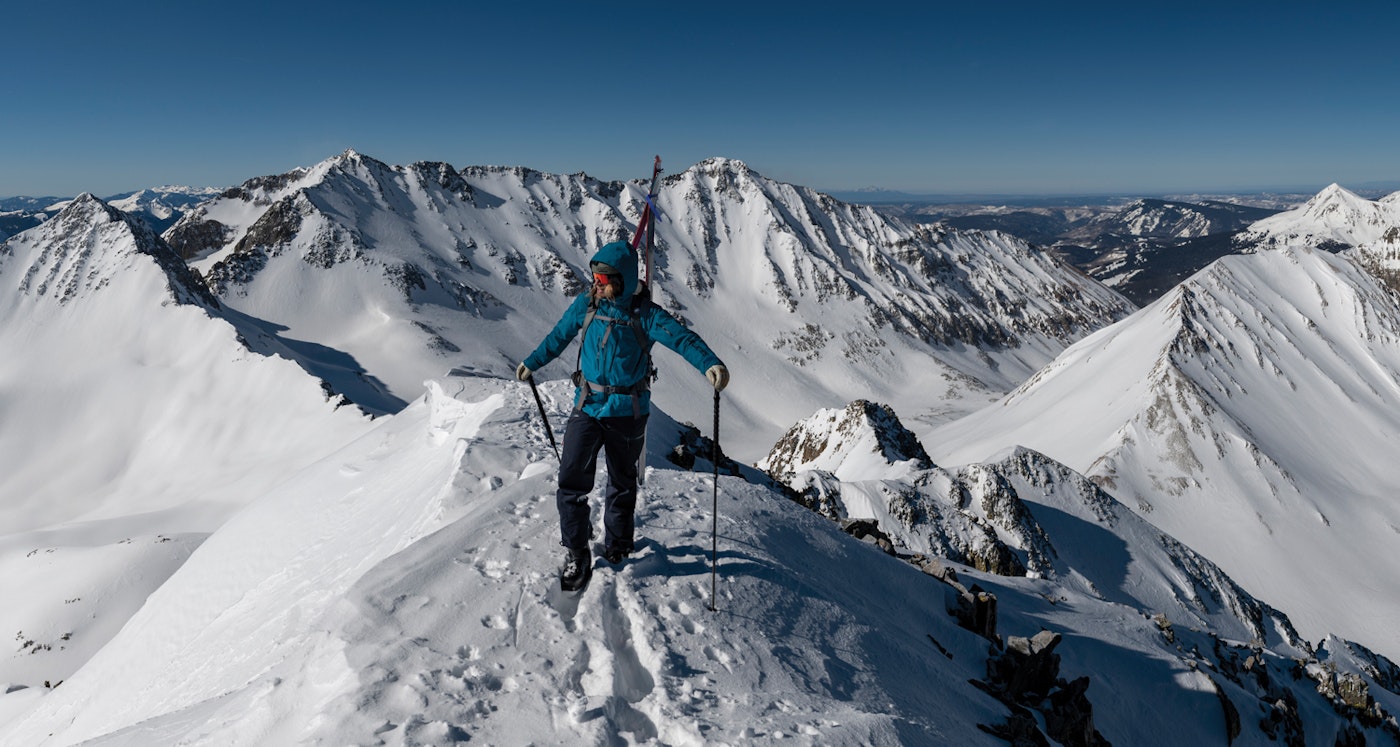
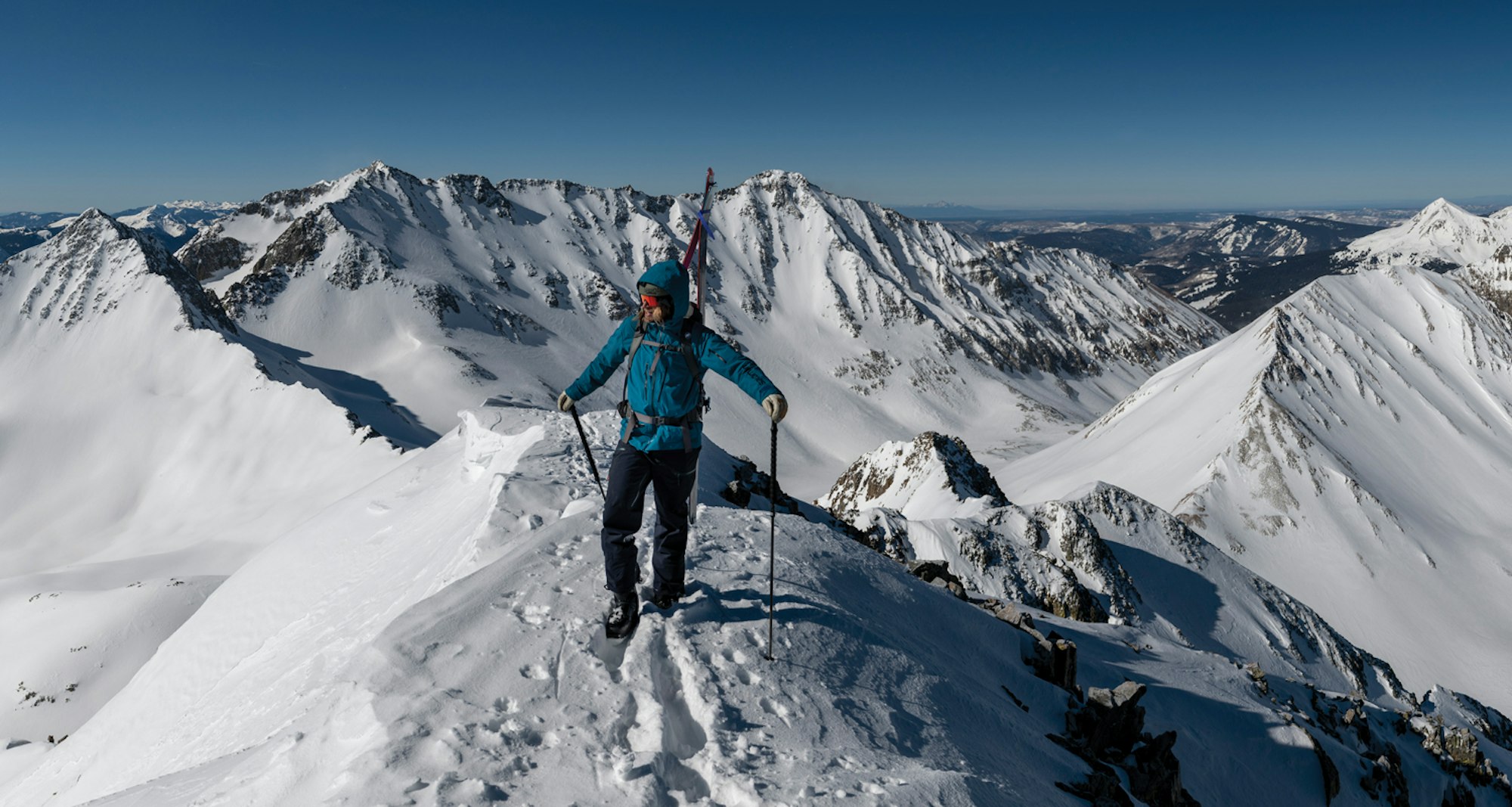
PHOTO: Weston Shirley | LOCATION: Wilson Peak, CO
This is the basis of the book that inspired the project, to ignite the shared spirit of the backcountry skier, the reward of earning your turns in the wilderness. The book was never meant to be a checklist and includes mountains that are accessible and relatively friendly to intermediate backcountry skiers, as well as those considered lifetime achievements—if completed.
“We didn’t want it to be just the steepest, gnarliest lines,” says Penn Newhard, co-author of 50 Classic Descents. “A lot of them can be done by a reasonably fit person. We wanted it to be sort of open-ended because that’s what backcountry skiing is, it’s about going out there, having fun, sharing the experience and serving the community more than anything else.”
A community of backcountry skiers has formed around Townsend’s project, taking pride in giving him beta about their local zones, hoping he comes to their town next and feeling inspired to tick off a few lines of their own. Local legends and friends of Townsend like Jimmy Chin, Pep Fujas and Pete Gaston even joined in on the fun.
“The amazing thing that he has going for him is that the entire backcountry ski community is stoked on what he’s doing,” adds Newhard.
That Townsend constructed the goal of completing all the lines takes the project one step above the book’s intention, of course, and pushes his series from simply relatable to a serial that is aspiring enough to keep people interested. Placing a three-year timeframe on a project of this magnitude is audacious. The descents, as Newhard described, run the gamut. They span 11 American states and three Canadian provinces/territories. Some are easily accessible—the Silver Couloir in Colorado, Mount Superior in Utah and Mount Washington in New Hampshire, for example. Others require huge efforts to get to, like the Giant Steps Couloir on California’s Mount Williamson or the Southwest Face of Mount Stimson in Montana. A few are not only remote, but reside in some of the most inhospitable places on the planet, like the Polar Star Couloir on Baffin Island, Canada, and University Peak and Mount Saint Elias, both found in Alaska’s Wrangell-Saint Elias Range, a place Townsend describes as having “the worst weather on Earth.”
Townsend is aware of the near-impossible mission of skiing all fifty objectives, let alone in a three-year timespan. But, in his typical cerebral approach, the time constraint was set intentionally as a motivator.
“I would say there’s a 95-percent chance I’m not going to do it in three years, but I wanted to push it that hard,” describes Townsend. “I wanted to answer the questions: ‘Could you do them fast? Could you tick off 20 lines in one year? Could you challenge yourself that hard, do a giant day and wake up the next morning and do it again? It was just asking myself, Can you do it?’ I think that’s kind of driven me through my whole ski career.”
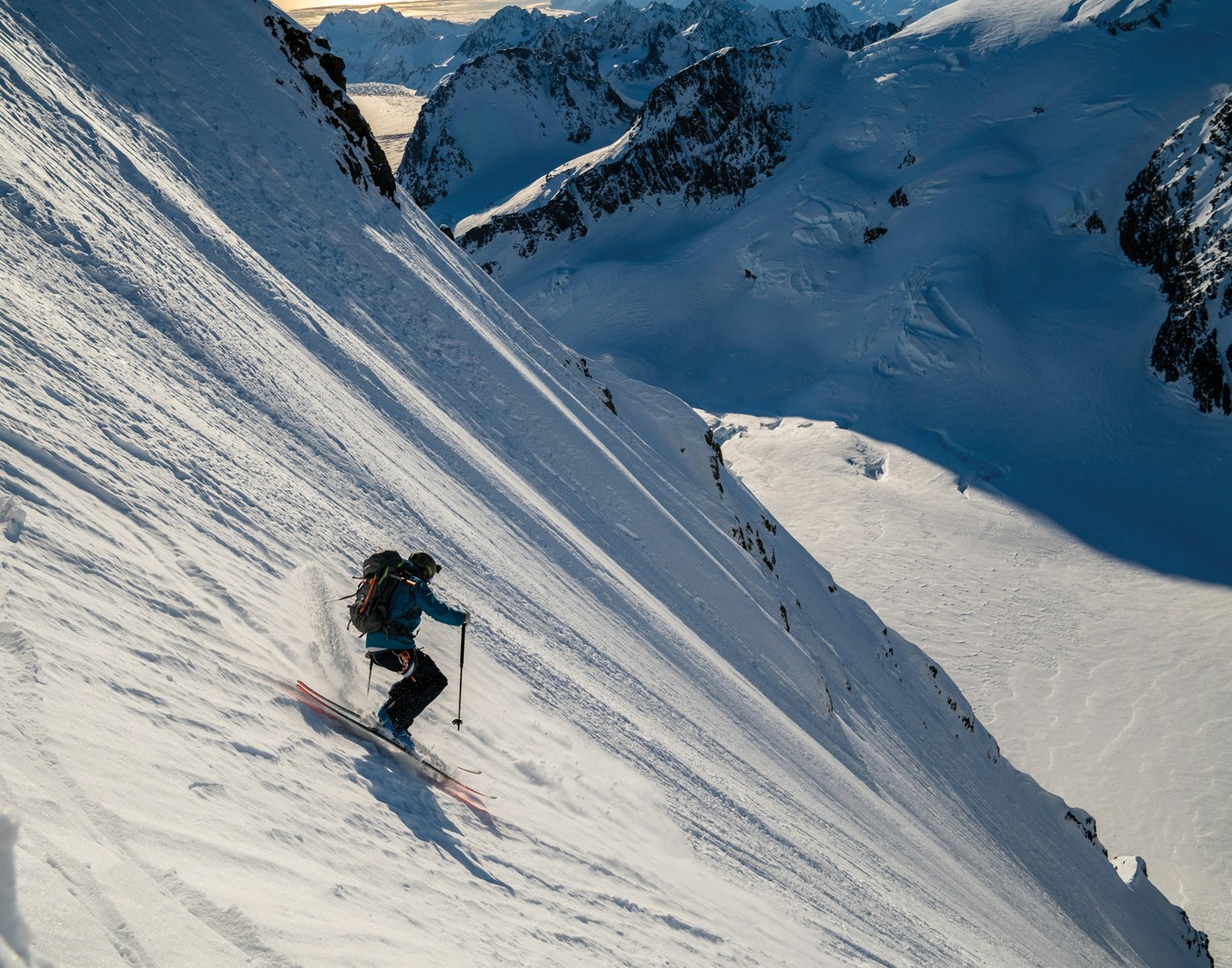
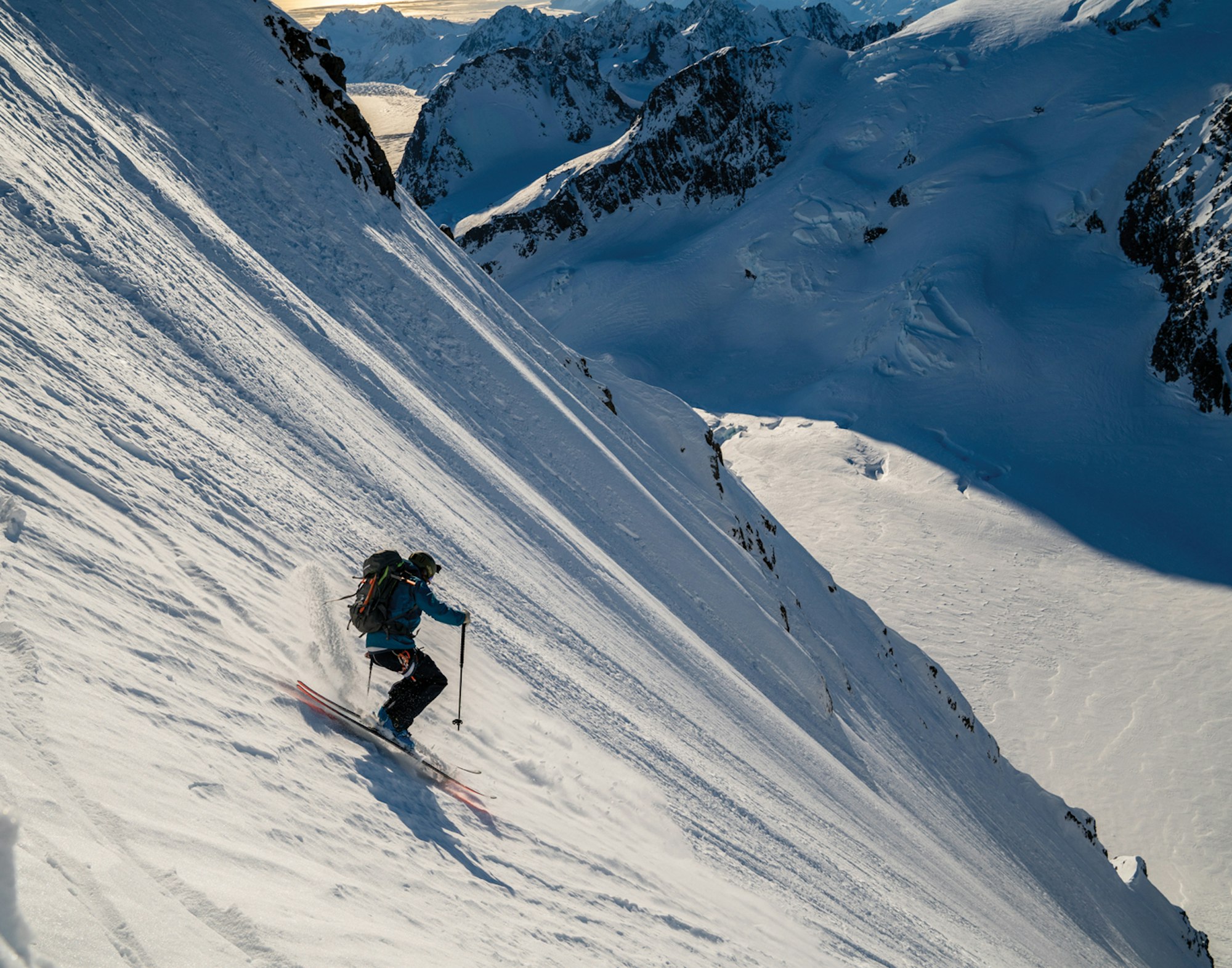
PHOTO: Ming T. Poon | LOCATION: The Sphinx, AK
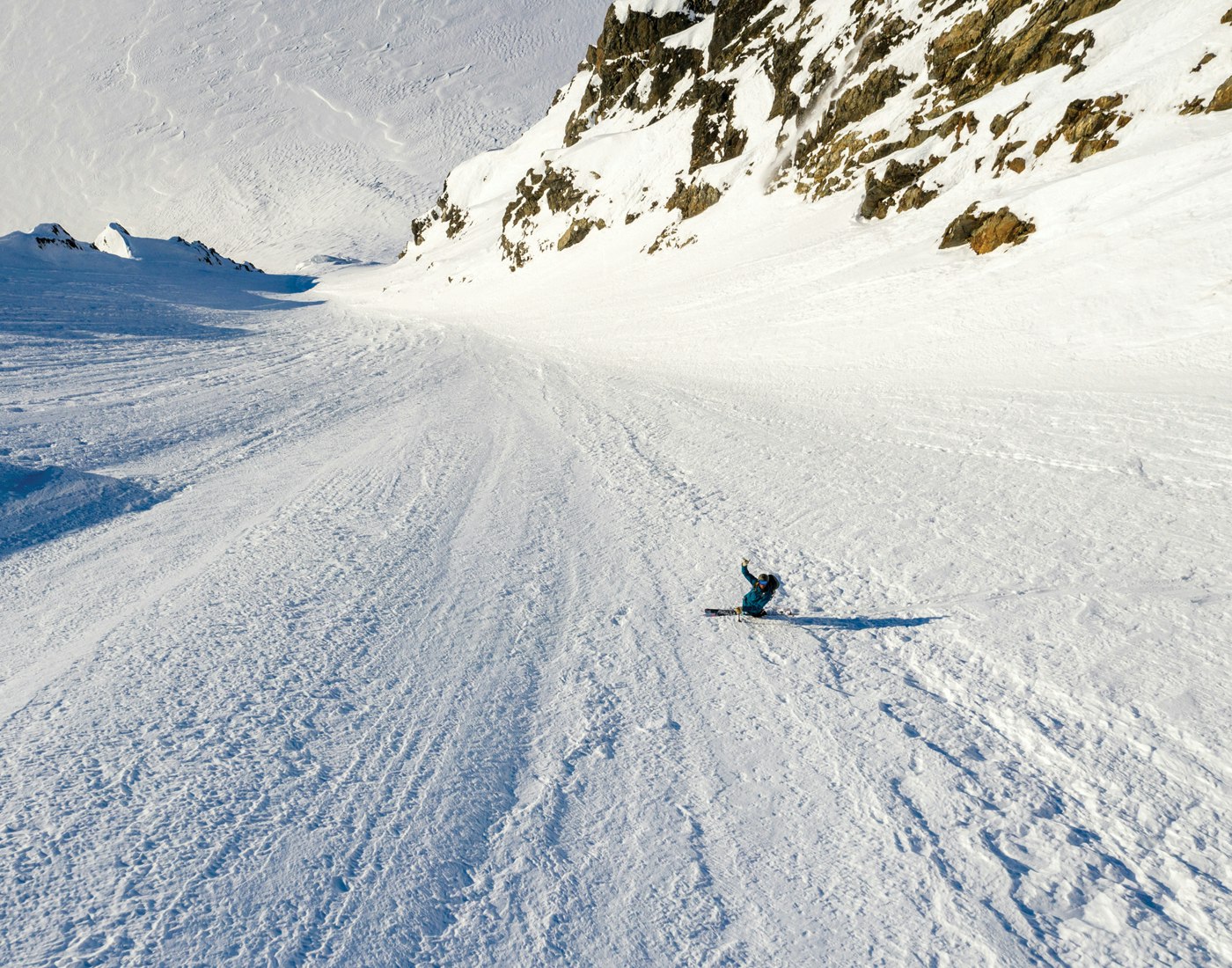
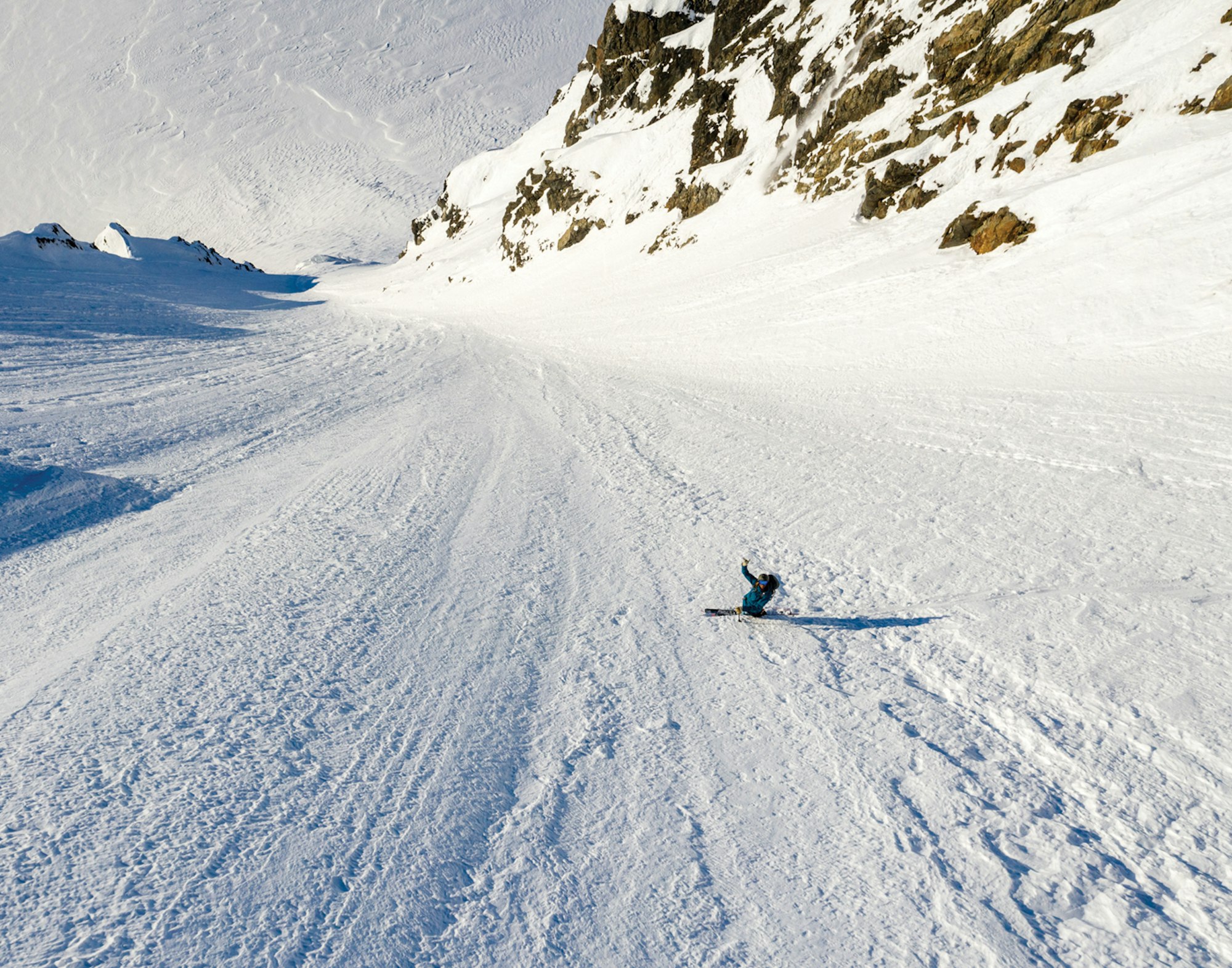
PHOTO: Ming T. Poon | LOCATION: The Sphinx, AK
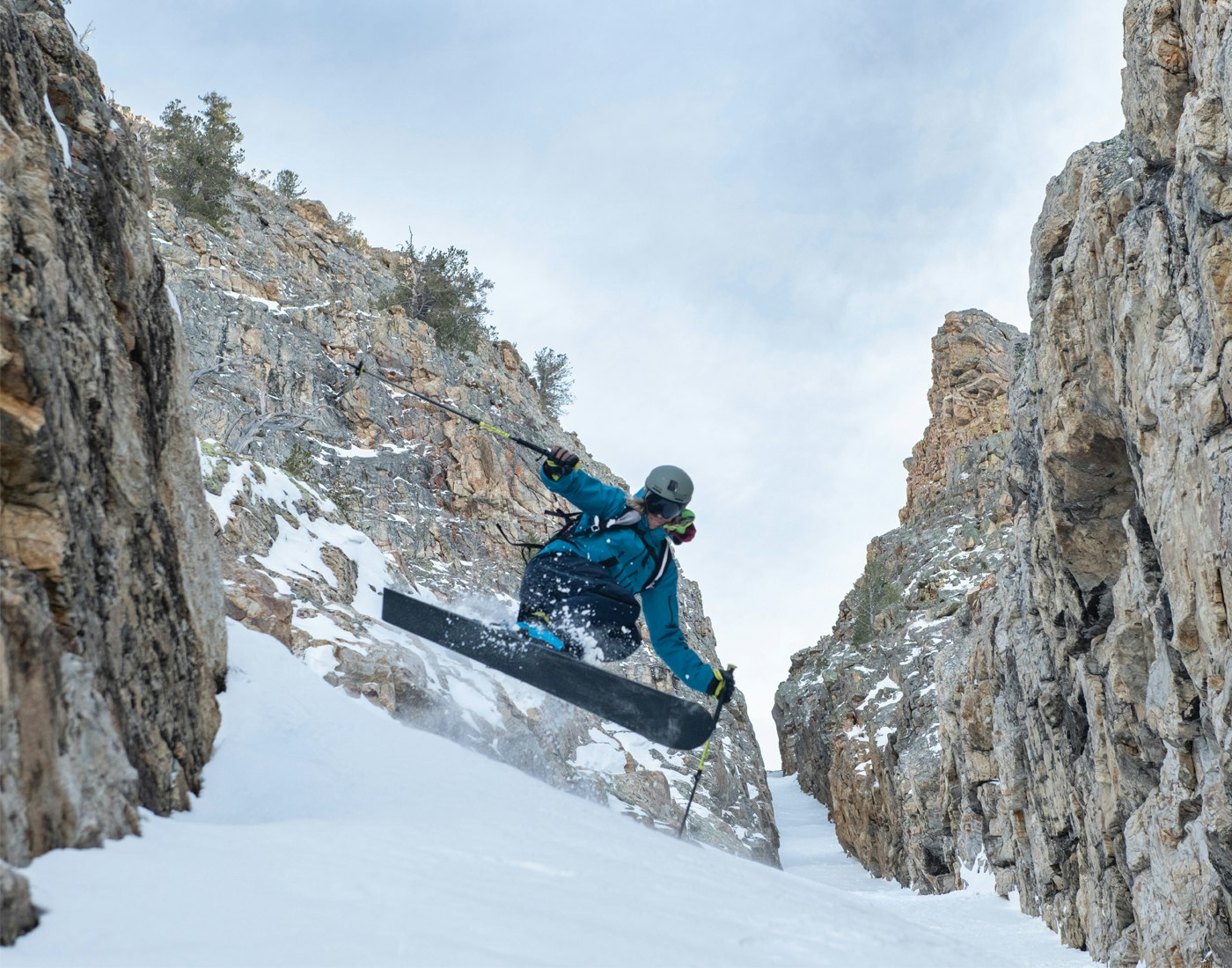
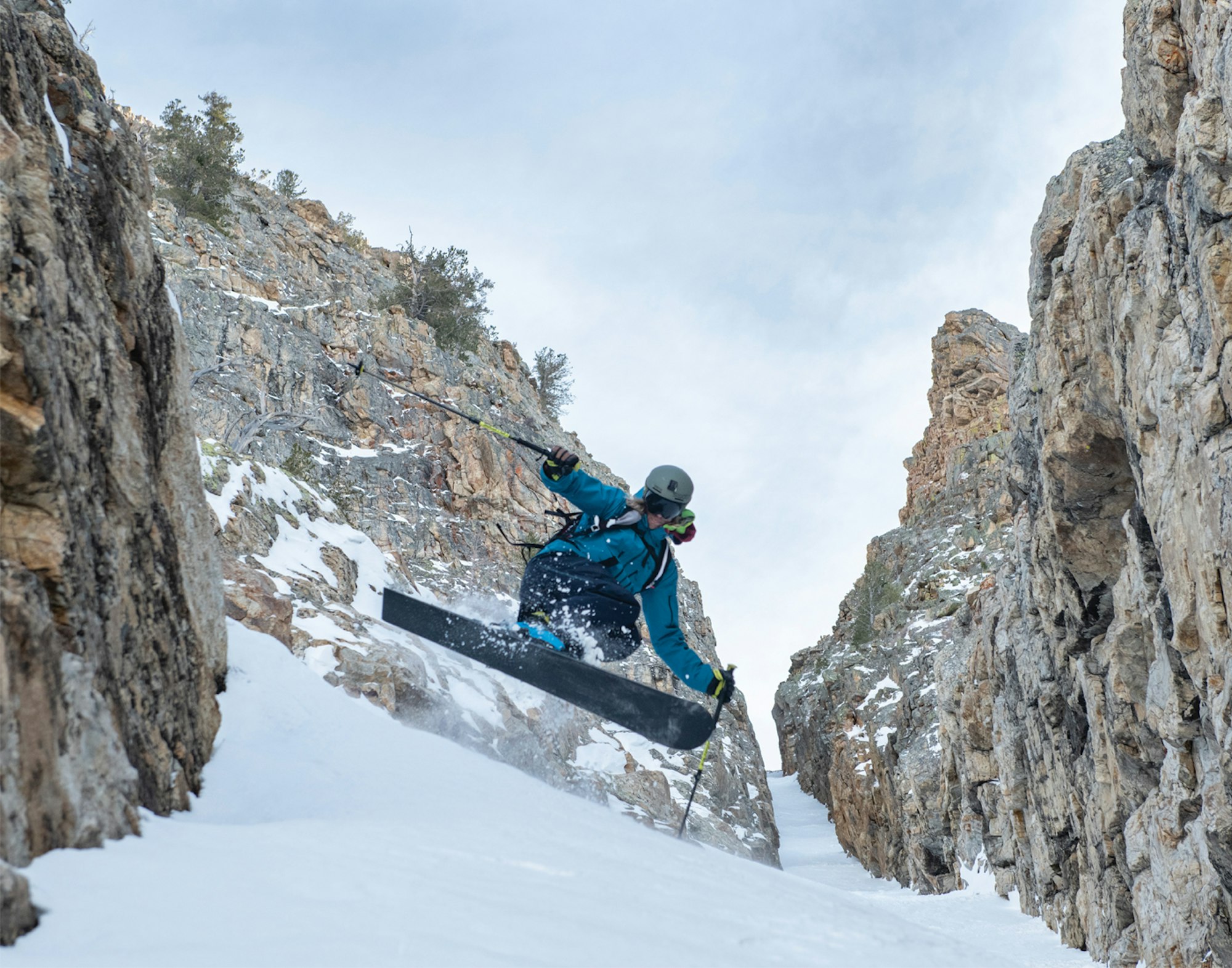
Townsend infuses episodes of The Fifty with humor; here, he completes the first mono-ski descent of the Terminal Cancer Couloir. | PHOTO: Weston Shirley
The danger factor adds to the strain of the enormous project, too. Each ski attempt comes with a multitude of inherent risks—snowpack conditions, potential weather, rockfall and exposure, among them—that can only be managed to a degree and not only dictate success of skiing a line, but can draw the line between life and death. The risks ignite his synapses, though, and allow him to use his brain to problem-solve, an approach well-suited for the project. He cites American sociologist Diane Vaughn’s theory, “Normalization of Deviance,” as an aid in making consistently safe backcountry decisions, just one of the logical ways he looks at the mountains. In the episode showcasing the completion of Joffre Peak, near Pemberton, British Columbia, Townsend and cinematographer Bjarne Salén come face to face with the possible consequences of attempting these 50 lines, but also receive positive reinforcement about the conservative choices they’ve made.
Townsend and Salén witness a man ragdoll hundreds of vertical feet down Joffre’s Central Couloir, a line they chose not to ski, opting for a secondary couloir based on conditions. In a heroic act, the two partners band together and move instantaneously—almost instinctively—to initiate a rescue that likely saved this man’s life. It was the rare case where Townsend received immediate affirmation in his decision-making. After judging the Central Couloir over the course of two trips to the top of Joffre, he and Salén deemed it unsafe to ski and chose a different descent. Even though the Central Couloir is the most prominent, aesthetic line on the face and would’ve looked best on camera, the decision to alter the route was validated.
“It does bring into the equation that the tiniest mistake can be fatal,” Townsend says. “But I looked at it in a different way, telling myself, ‘Being prepared, being calculated and being cautious with your decision-making is the right way to do this.’”
It’s this approach that takes some of the burden of worrying away from people like Peggy Townsend and Saugstad. “I really trust Cody. He’s one of those people who doesn’t do something just to be filmed,” says Peggy. “He does it because he loves it, he planned it before, thinks it’s safe and thought about it from all angles.”
Townsend has three guidelines that dictate the project: 1. Don’t die. 2. Have fun. 3. Ski the 50 lines. With his main focus on safety, an admission that none of these goals is worth dying over, it begs the question of whether the main point of all of this is to actually complete the 50 Classic Ski Descents, or whether it’s simply to have fun while immersing himself in these sublime mountains.
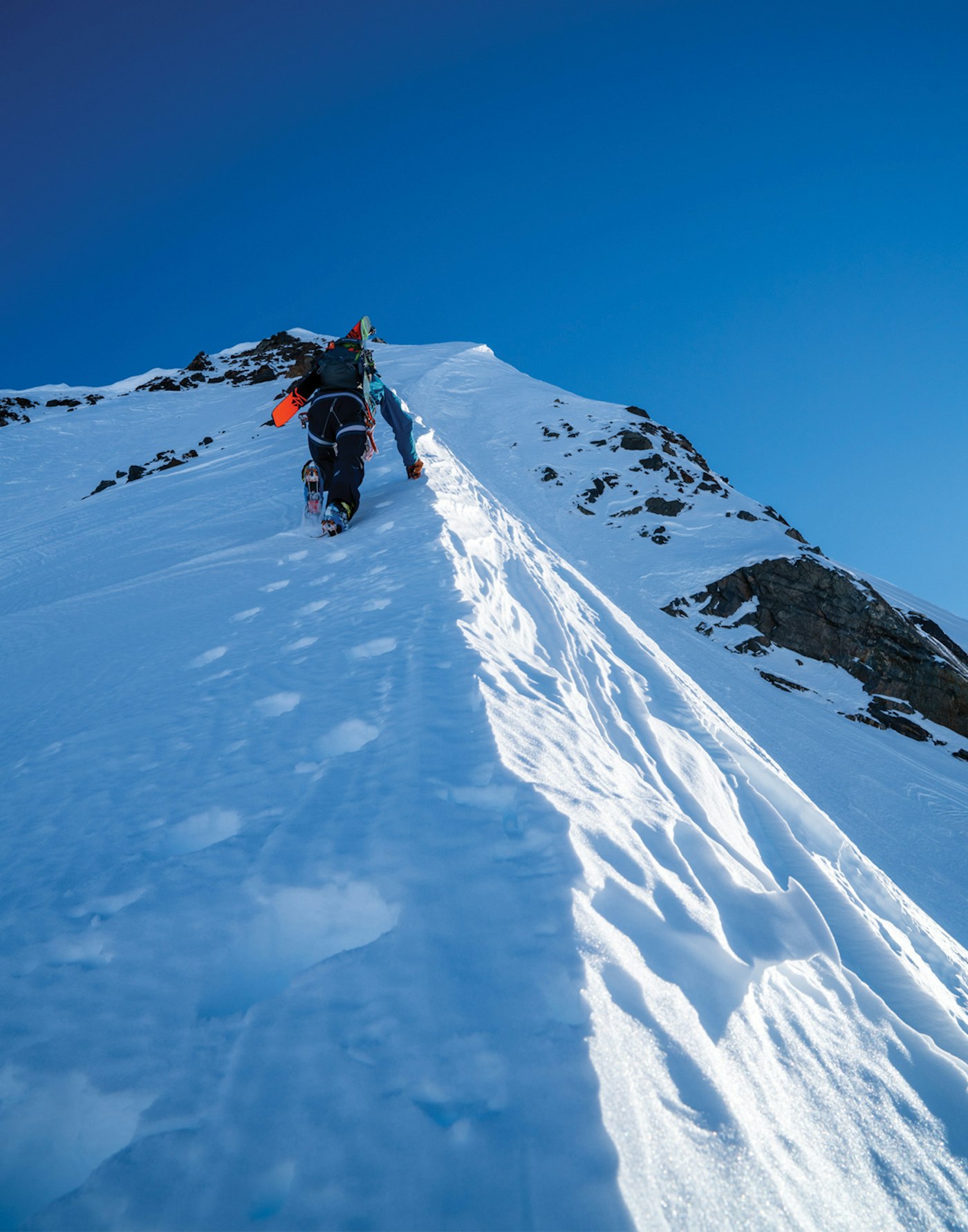
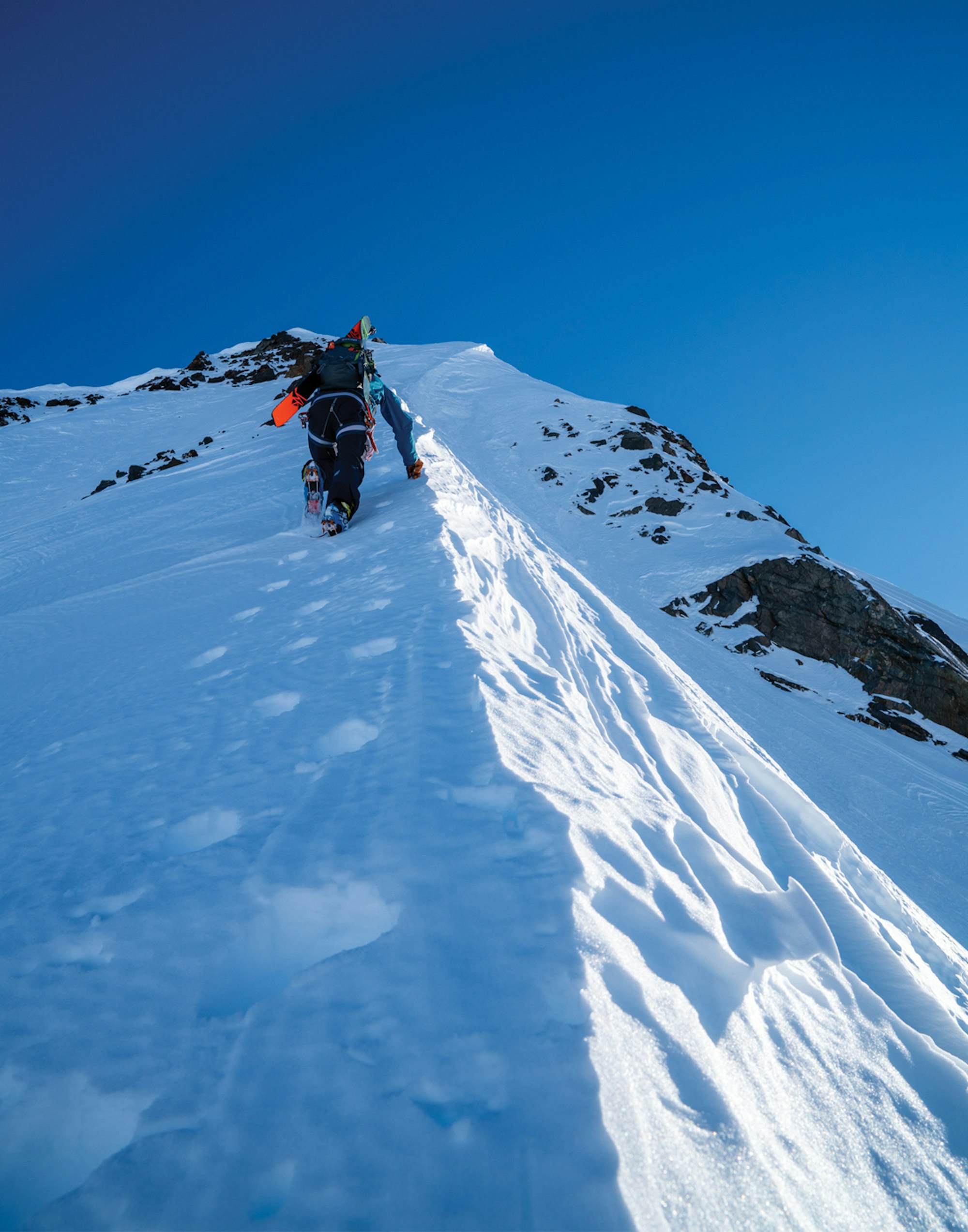
PHOTO: Ming T. Poon | LOCATION: The Sphinx, AK
The Fifty is a personal project that is also about teamwork, friendship and community and Townsend guarantees fun by involving like-minded skiers and friends to help him.
But, in the end, it’s Townsend’s goal and it defines the latest chapter of his career—one focused less on helicopters, backflips and cliff drops. An outside perspective may equate The Fifty’s success to completing all of the lines in three years, but that’s far from reality and a superficial way of digesting the series. For Townsend, the project is already a success, because he’s flipping years of planning into action, challenging himself, making smart decisions, having fun with skiers like himself and interacting with passionate communities. In the episode highlighting Wyoming’s Middle Teton, he relates veteran climbers Mark and Janelle Smiley’s decision to back away from completing the Fifty Classic Climbs of North America with just three left, to help the viewer understand his goals.
“It was a way to translate to the audience that ‘failure’ is the most likely outcome, in terms of skiing all 50,” Townsend says, but “the only true failure, to me, is dying. Tying yourself to an arbitrary number is a dumb way to live and not ultimately what the project is about. The ultimate goal is to see if I can do this, so, if I get to a point where I can’t, then I answered my question.”
“I think he set this timeline because he should be able to get most of those lines in three years, make episodes out of it and really create an audience,” adds Saugstad. “And if it means that there’s two left at the end, it may take some time and it’ll eat at him, but it’s OK. I will be there to remind him that really wasn’t the entire purpose of this project; it’s about the journey, not the end goal.”
The audience Townsend’s built is a strong one. Upwards of forty Front Range locals show up for the intimate Peak Obsession premiere in Arvada. When the credits roll, fans swarm him, ask questions, relate their own backcountry experiences and take photos. I see the community spirit firsthand and how he relishes sharing his journey with others. The next morning, he’s off to France, and will sprinkle in more premieres and weighted-down hikes into his schedule. Then, the snow will flutter from the sky, the lines will fill back in and he’ll take to the mountains focused on the remaining 30 lines. Townsend isn’t the most probable skier to tackle these grand descents, but, that’s what makes him the perfect person to attempt The Fifty.
This story originally appeared in FREESKIER 22.3, The Backcountry Issue.

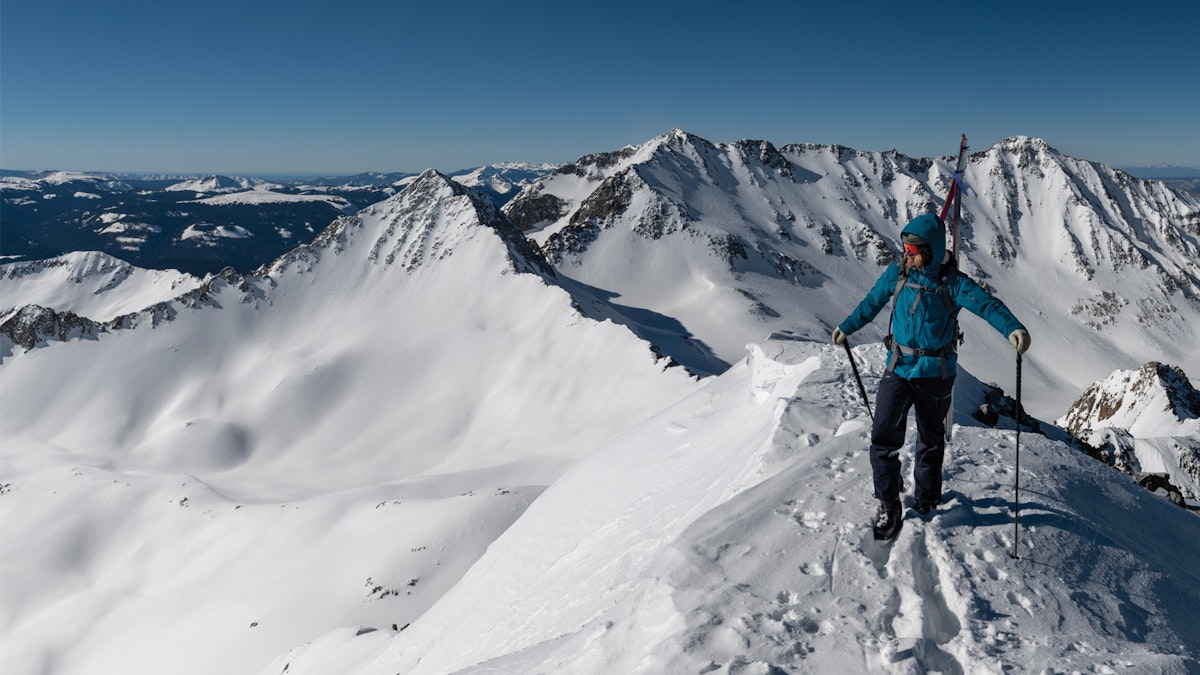

![[GIVEAWAY] Win a 4-Night Karma Campervan Rental and go Ski the Powder Highway](https://www.datocms-assets.com/163516/1767816935-copy-of-dji_0608-1.jpg?w=200&h=200&fit=crop)
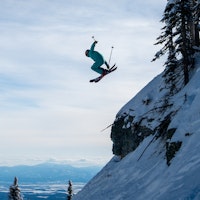

![[GIVEAWAY] Win a Legendary Ski Trip with Icelantic's Road to the Rocks](https://www.datocms-assets.com/163516/1765233064-r2r26_freeskier_leaderboard1.jpg?auto=format&w=400&h=300&fit=crop&crop=faces,entropy)
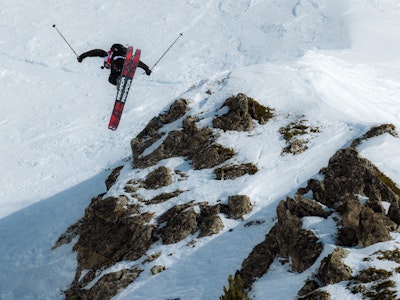
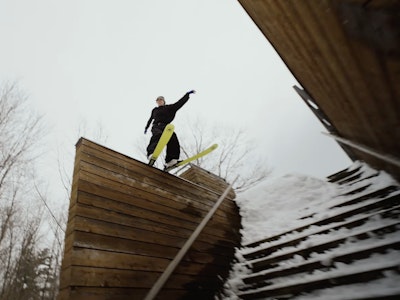
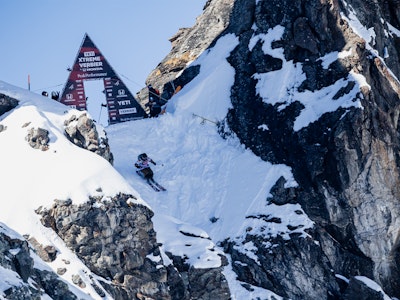



![[GIVEAWAY] Win a 4-Night Karma Campervan Rental and go Ski the Powder Highway](https://www.datocms-assets.com/163516/1767816935-copy-of-dji_0608-1.jpg?auto=format&w=400&h=300&fit=crop&crop=faces,entropy)
